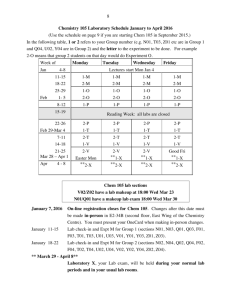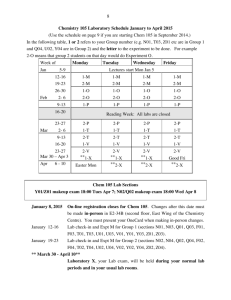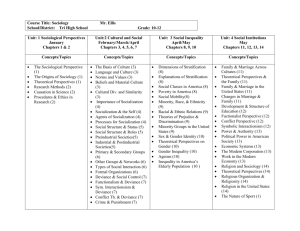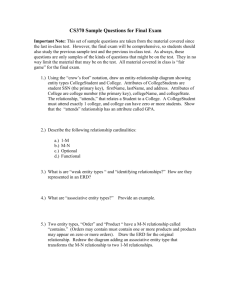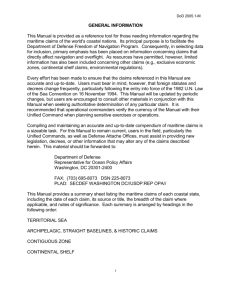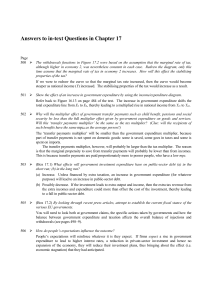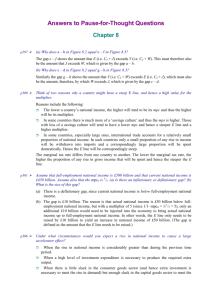National income accounting and determination
advertisement
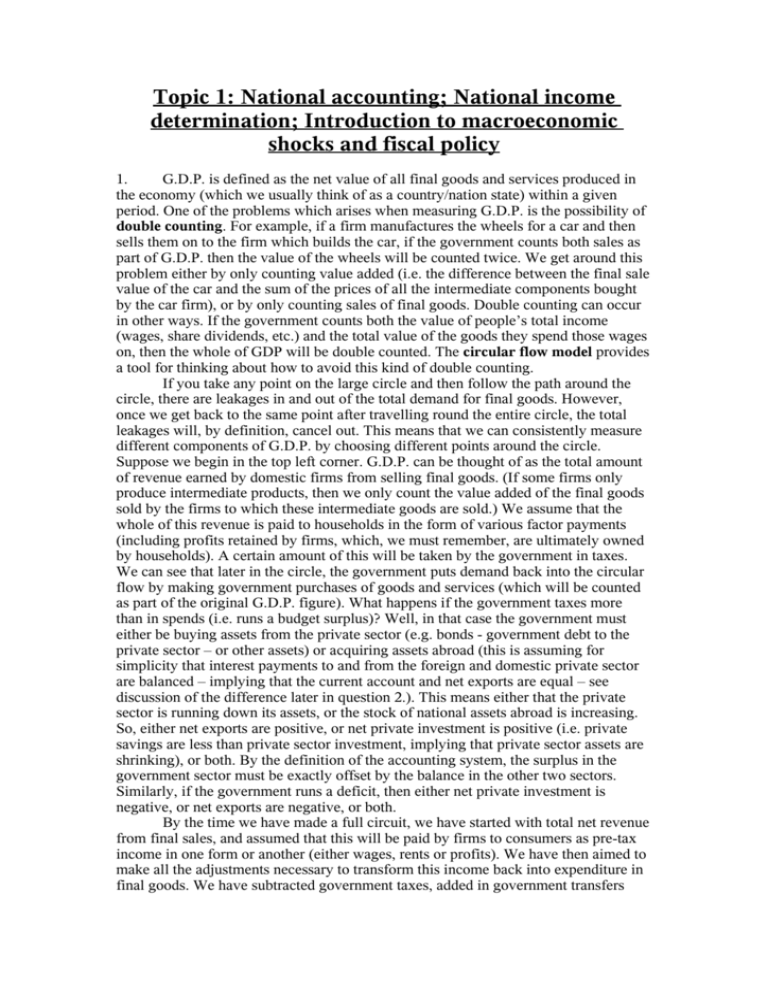
Topic 1: National accounting; National income determination; Introduction to macroeconomic shocks and fiscal policy 1. G.D.P. is defined as the net value of all final goods and services produced in the economy (which we usually think of as a country/nation state) within a given period. One of the problems which arises when measuring G.D.P. is the possibility of double counting. For example, if a firm manufactures the wheels for a car and then sells them on to the firm which builds the car, if the government counts both sales as part of G.D.P. then the value of the wheels will be counted twice. We get around this problem either by only counting value added (i.e. the difference between the final sale value of the car and the sum of the prices of all the intermediate components bought by the car firm), or by only counting sales of final goods. Double counting can occur in other ways. If the government counts both the value of people’s total income (wages, share dividends, etc.) and the total value of the goods they spend those wages on, then the whole of GDP will be double counted. The circular flow model provides a tool for thinking about how to avoid this kind of double counting. If you take any point on the large circle and then follow the path around the circle, there are leakages in and out of the total demand for final goods. However, once we get back to the same point after travelling round the entire circle, the total leakages will, by definition, cancel out. This means that we can consistently measure different components of G.D.P. by choosing different points around the circle. Suppose we begin in the top left corner. G.D.P. can be thought of as the total amount of revenue earned by domestic firms from selling final goods. (If some firms only produce intermediate products, then we only count the value added of the final goods sold by the firms to which these intermediate goods are sold.) We assume that the whole of this revenue is paid to households in the form of various factor payments (including profits retained by firms, which, we must remember, are ultimately owned by households). A certain amount of this will be taken by the government in taxes. We can see that later in the circle, the government puts demand back into the circular flow by making government purchases of goods and services (which will be counted as part of the original G.D.P. figure). What happens if the government taxes more than in spends (i.e. runs a budget surplus)? Well, in that case the government must either be buying assets from the private sector (e.g. bonds - government debt to the private sector – or other assets) or acquiring assets abroad (this is assuming for simplicity that interest payments to and from the foreign and domestic private sector are balanced – implying that the current account and net exports are equal – see discussion of the difference later in question 2.). This means either that the private sector is running down its assets, or the stock of national assets abroad is increasing. So, either net exports are positive, or net private investment is positive (i.e. private savings are less than private sector investment, implying that private sector assets are shrinking), or both. By the definition of the accounting system, the surplus in the government sector must be exactly offset by the balance in the other two sectors. Similarly, if the government runs a deficit, then either net private investment is negative, or net exports are negative, or both. By the time we have made a full circuit, we have started with total net revenue from final sales, and assumed that this will be paid by firms to consumers as pre-tax income in one form or another (either wages, rents or profits). We have then aimed to make all the adjustments necessary to transform this income back into expenditure in final goods. We have subtracted government taxes, added in government transfers (e.g. welfare benefits), subtracted private sector savings (e.g. payments into bank accounts), added in private sector investment (e.g. firms borrowing money from banks to finance capital investment), subtracted imports (leakages of income which are spent abroad and so do not count as part of G.D.P.) and, finally, added in exports (injections into domestic demand from incomes earned abroad). If all of these factors are properly counted, then we will end up back where we started, with final expenditure on domestic goods and services, i.e. G.D.P. This fact about the circular flow model, that a full circuit takes us back to where we started, leads to the three main alternative ways to measure G.D.P.: 1. Total expenditure on final goods 2. Total value added 3. Total income (i.e. total pre-tax factor payments) Another issue surrounding G.D.P. is the degree to which it actually measures the total economic welfare generated in a particular geographical area in a particular period. Since G.D.P. is calculated using the market prices at which goods sell, it relies on the assumption that markets are competitive and complete (basically, the assumptions of the First Theorem of Welfare Economics) if prices are to accurately reflect the valuations placed upon goods by consumers. This means that in countries where markets do not really function adequately (e.g. the old Soviet Union), G.D.P. measured at market prices will probably be hopelessly inadequate. In fact, even if markets are competitive and complete, prices only reflect the marginal valuations placed upon goods by consumers, so even then G.D.P. will not be an entirely accurate measure of the consumers’ and producers’ surplus generated from consuming a good. The microeconomic basis of G.D.P. becomes even more doubtful when we consider the prevalence of externalities and the existence of “bads”. For example, goods like clean air and water which do not have well defined property rights are not paid for and therefore do not enter into G.D.P. Expenditure on prisons and national defence count as part of G.D.P., even though their existence is purely to alleviate a “bad” rather than to produce net economic welfare. Also, the value of people’s leisure time – by definition unsold labour- is not counted in G.D.P. This had led some economists to attempt to develop more refined measures of economic welfare which take into account these factors. The advantage of G.D.P. remains, however, that it is fairly straightforward and unambiguous compared to the alternatives. For many macroeconomic questions, it is most useful as a measure of total output rather than as a tool for welfare economic analysis. From a macroeconomic standpoint, we hope that government policy will be correctly designed at the micro-level to roughly offset these externalities so that G.D.P. will still roughly be a measure of overall welfare. Macroeconomics generally concerns itself with how to reduce the welfare losses from unemployment and inflation. It is reasonable in this context to simplify away the many other welfare orientated issues which are the concern of microeconomic policy. 2. (i) The Keynesian multiplier model is based on the idea that in equilibrium planned aggregate expenditure (AE) must equal income/output (Y) (income and output are identical by definition because the total value of output is paid to households as factor payments, as described in question 1). The easiest way to understand the model is to imagine that prices are fixed (we will justify this assumption in future weeks; for now, think of it as a simplification). Firms adjust to equilibrium purely by altering their output levels. Suppose that we are away from equilibrium so that current planned expenditure is less than output. Firms would be building up inventories of finished goods; this would lead them to reduce output, thus bringing the economy closer to equilibrium. If current expenditure were greater than output, firms would be running down their inventories. They would therefore increase output. In equilibrium, we have that AE=Y. Planned aggregate expenditure is a function of consumption spending, investment spending and government spending: AE=C+I+G. Consumption spending is a function of income. For simplicity, we assume that a certain fixed proportion of income, (1-s)(1-t)Y, is spent. We call s the marginal propensity to save, and t is the tax rate. So, if s=0.1 then 10% of (post-tax) income is saved and 90% is consumed. We also assume that there is a certain amount of autonomous consumption (C0) which is always consumed (this could be due, for example, to welfare payments or consumption out of accumulated consumer wealth). Combining the above information, we have Y=(1-s)(1-t)Y +C0+I0+G. Rearranging, we have Y=(C0+I0+G)(1-(1-s)(1-t))-1. When there is a 1 unit increase in the amount of autonomous consumption, investment or government spending, the overall effect on aggregate income/expenditure/output in equilibrium is 1/(1-(1-s)(1-t)). This value is called the Keynesian multiplier. Provided either s>0 or t>0, the multiplier will be greater than 1. The smaller are s and t, the greater is the multiplier. The multiplier is greater than 1 because when, for example, new government expenditure is injected into the economy, this creates new incomes (e.g. for government workers or people employed to produce goods bought by the government such as armaments), part of which is spent on greater consumption. Part of this extra consumption demand is again consumed, and so on. This creates an infinite geometric series of additional demand expansions in the form of ∑r=0∞((1-s)(1-t))r. The larger the amount saved or taxed of each income payment, the larger will be the leakages and the smaller will be the overall effect (i.e. the infinite sum of the geometric series). (ii) Net exports (NX) is equal to total value of exports minus total value of imports. (Note that the trade balance is different because it refers only to physical goods, not services also, which are counted in net exports.) Exports add to demand for domestic output, but imports must be subtracted from it because they represent domestic income which is spent on goods produced abroad. The current account is equal to net exports plus net transfers from abroad (transfers include interest payments on money lent abroad, interest payments on money borrowed from abroad, profits from foreign branches of domestic companies, profits taken from the domestic economy by domestic branches of foreign owned firms etc.). It is the balance between national earnings and expenditures abroad. If the current account is in surplus, the country is earning more than it is spending abroad. This means that the country must be building up its reserves of foreign currency or other assets. If the current account is in deficit, then the country must be borrowing currency or assets from abroad, or running down its reserves of foreign currency or assets. To illustrate the relevance of the current account, suppose that a country is in debt to foreigners. The country would then have to run a surplus either in its government budget or private sector savings balance in order to prevent getting further into debt, because to avoid borrowing money it has to achieve 0 net exports and pay the interest payments on its debt. We can extend the multiplier model into the open economy by defining net exports as NX=X0-m(1-t)(1-s)Y where X0 is autonomous exports and m is the marginal propensity to import (out of post-tax, non saved income – which is private consumption expenditure). The equilibrium equation now becomes Y=((1-s)(1-t)(1-m))Y +C0+I0+G+X0. This implies that Y=γA0, where the multiplier γ = (1-(1-s)(1-t)(1-m))-1 and A0= C0+I0+G+X0, which we call autonomous expenditure. The multiplier is decreasing in the marginal propensity to import, because the greater is m, the more domestic income leaks out as foreign import demand, and so the smaller is the sum of the infinite series of demand created by the autonomous expenditure A0. (iii) (a) When the marginal propensity to save, s, increases, it is clear that the multiplier decreases. Given that all the other parameters are fixed, this will result in a reduction in aggregate demand/output/income Y. The overall amount of income saved is S=sY. We can find the effect of an increase in the marginal propensity to save on the overall amount saved by using the product rule to give ∂S/∂s=Y+s∂Y/∂s. Now, using the chain rule, ∂Y/∂s=-(1-t)(1-m)(1-(1-s)(1-t)(1-m))-2A0. So ∂S/∂s=Y(1-s(1-t)(1-m)(1-(1-s)(1-t)(1-m))-1)=Y(1-s(1-t)(1-m)γ). In order for ∂S/∂s to be positive, we require that the following condition be fulfilled: 1-s(1-t)(1-m)γ > 0 γ-1 > s(1-t)(1-m) 1-(1-s)(1-t)(1-m) > s(1-t)(1-m) 1 > (1-t)(1-m) Provided either t>0 or m>0, this inequality will always hold. So, increasing the savings rate always increases the overall amount of savings (and thus improves the private sector net savings balance). This is because the reduction in Y brought about by increased savings is always outweighed by the fact that proportionally more of it is being saved. (b) An increase in wages paid to NHS nurses will increase government expenditure. Given that all the other parameters are fixed, this will lead to an expansion in output determined by the multiplier. Aggregate demand will increase by more than £1 for each extra £1 of government expenditure. Now, although the government will be spending more, its tax receipts will also have increased due to the increase in Y. Could the increase in taxes from the stimulus to the economy outweigh the increase government outlays and improve the budget deficit? The answer is “no”. The government budget surplus is equal to BS=tY-G. So, the change in the budget surplus when G is increased at the margin is ∂(BS)/∂G = t∂Y/∂G – 1. Now, ∂Y/∂G = γ (the multiplier). So, for ∂(BS)/∂G to be positive, we require that: tγ-1 > 0 t > γ-1 t > 1-(1-s)(1-t)(1-m) (1-t)(1-(1-s)(1-m)) < 0 This inequality can never be fulfilled. It therefore must be the case that increased government expenditure without a rise in the tax rate will worsen the government budget deficit (or reduce the surplus). In order to increase expenditure without raising taxes, the government must borrow from the private sector (i.e. private sector savings will be in excess of private sector investment) or net exports must be negative (i.e. the economy must be spending more on imports than it is earning from exporting goods). Usually, a government deficit will be reflected both in reduced private sector investment and a worsened current account balance. (c) An increase in the proportional income tax will decrease the multiplier. This will reduce output. If we differentiate the output with respect to t, we get ∂Y/∂t = - (1-s)(1-m)(1-(1-s)(1-t)(1-m))-2A0. Since the total tax revenue T is equal to tY, the change in tax revenue from increasing t is equal to ∂T/∂t =Y+t∂Y/∂t, which gives us ∂T/∂t = Y(1-t(1-s)(1-m)(1-(1-s)(1-t)(1-m))-1) = Y(1-t(1-s)(1-m)γ). The condition for an increase in the tax rate to reduce the overall tax revenue is therefore (1-t(1-s)(1-m)γ)<0, which implies: γ-1 < t(1-s)(1-m) 1-(1-t)(1-s)(1-m) < t(1-s)(1-m) 1-(1-s)(1-m) < 0 Since 0≤s<1 and 0≤m<1, this clearly cannot occur. Therefore, at all tax rates, although raising the tax rate reduces overall output Y, it still increases tax revenue T, and therefore improves the government’s budget balance. (d) If the government increases government expenditure by an amount such that the government budget remains balanced, then we have that tY=G. Rearranging the equilibrium equation Y=((1-s)(1-t)(1-m))Y +C0+I0+G+X0, we get Y=(1-s)(1-m)Y-(1-s)(1-m)tY +C0+I0+G+X0 Y=(1-(1-s)(1-m))-1(C0+I0+(1-(1-s)(1-m))G+X0) The derivative of Y with respect to G is ∂Y/∂G = (1-(1-s)(1-m)) -1(1-(1-s)(1-m)) = 1. The balanced budget multiplier is 1. This is because although the government takes out an equal amount of demand as it puts into the economy, so that the infinite series of “knock-on effects” no longer occurs, it still demands a service in exchange for the initial injection (the initial increase in G). To make this clearer, compare an increase in G to simply the introduction of new taxes and benefits (e.g. higher income tax and higher unemployment benefits so that the budget balance remains unchanged). In this case, ignoring the microeconomic considerations of the cost of collecting the tax and the distortions introduced into the economy (and assuming autonomous consumption is not affected), there is no overall impact on Y (because net taxation has remained unchanged). All the government does with offsetting taxes and transfers is to move “purchasing power” between individuals, rather than to create new demand. However, this is not the case with increased balanced budget government expenditure, because the government demands a service in exchange for the “transfer”, whilst raising the tax revenue from private economic activity. Hence there is an increase in overall output equal to the expansion in G. (e) A boom in the US will increase autonomous exports X0. This will clearly increase autonomous expenditure and therefore output. On the other hand, because Y has increased, so will import demand mY. Can it be the case that the increased import demand more than offsets the increase in autonomous exports and causes net exports to decrease? The answer is “no”. Net exports are given by NX=X0-mY. The change in net exports when X0 increases is therefore given by ∂(NX)/∂X0=1-m∂Y/∂X0. Now, ∂Y/∂X0= γ. Therefore, for the effect on net exports to be negative, we require that:1-mγ < 0 m > γ-1 m > 1-(1-t)(1-s)(1-m) (1-m)(1-(1-t)(1-s)) < 0 This inequality clearly cannot hold, so it must be the case that a boom in the export market increases both output Y and net exports NX. (f) An increase in the marginal propensity to import will, via the multiplier, increase leakages and therefore reduce output. The effect on net exports requires the comparison of two opposing effects; the increase in m increases the amount of imports, but the decrease in Y decreases the amount of imports. Again, we can show that the first effect dominates. The change in net exports when m changes is given by ∂(NX)/∂m=-Y-m(∂Y/∂m). Now, ∂Y/∂m=-(1-t)(1-s)(1-(1-s)(1-t)(1-m))-2A0 =-Y(1-t)(1-s)γ. This implies that ∂(NX)/∂m=Y(-1+m(1-t)(1-s)γ). For this to be positive, we would require:-1+m(1-t)(1-s)γ > 0 m(1-t)(1-s) > γ-1 m(1-t)(1-s) > 1-(1-s)(1-t)(1-m) (1-m)(1-(1-s)(1-t)) < 0 This inequality clearly cannot hold, and so this establishes that an increase in the marginal propensity to import decreases net exports (i.e. makes the current account worsen), as well as decreasing domestic output. 3. Macroeconomic shocks can be thought of as shifts in autonomous expenditure. For example, if there is a worldwide recession, then autonomous exports X0 would be likely to reduce. If business lost confidence, then autonomous investment I0 would be reduced. If there was a consumer spending boom brought about by changes in lending laws, then autonomous consumption C0 might increase. The changes in A0 feed through into changes in Y via the multiplier. The larger is the multiplier, the greater will be the overall effect of the shock. Automatic stabilizers are factors which reduce the size of the multiplier, so that the effect of macroeconomic shocks on output are smaller. So, for example, a higher tax rate, savings rate or marginal propensity to import all reduce the size of the multiplier. Although the usefulness of this is a little obscure in this simple model, when we bring in the model of the supply side in future weeks, we will see that if output is below the capacity of the economy there will be undesirable unemployment, and if output is above the supply capacity of the economy there will be undesirable inflation. If there are shocks to autonomous expenditure, we would therefore on average like to smooth them out so that unemployment and inflation can be avoided. All of the parameters which affect the size of the multiplier are therefore useful policy tools in this context. For example, if the government taxes private income and spends this revenue on government expenditure, then this provides a cushion against shocks to autonomous expenditure because G is fixed independently of Y. So, if the government was planning a balanced budget and then Y turned out to be lower than expected, tax revenues would be smaller than G and so the government would be running a deficit. This would automatically provide an extra boost for the economy. By contrast, if Y was higher than expected, the planned government expenditure and tax rules would result in a surplus, and this would provide an automatic brake on the economy, reducing the danger of inflationary pressure. Private savings and imports provide a similar effect. If some of the economy’s demand is fixed as autonomous exports, then a loss in domestic consumer confidence will not have such a drastic effect, because some of the consequences will leak abroad. This means that an open economy probably has greater stability and insulation than a closed economy. Similarly, if some income is saved, and there is some autonomous expenditure determined by firms (as autonomous investment), then this reduces the effect of a shock to any one component of autonomous expenditure. Discretionary fiscal policy changes refer to changes in the actual parameters which can be controlled by the government (either t or G) is response to macroeconomic shocks. So, for example, if there is a collapse in consumer and investor confidence (reduction in C0 and I0) then the government could cut taxes and/or increase government expenditure in order to stimulate the economy. Keynes advocated discretionary fiscal policy as a policy solution during the great depression of the 1930s. However, there are a number of good arguments against it:1. 2. It is very clumsy – by the time governments have persuaded legislatures to vote for spending increases, the situation is likely to have changed. It is difficult to reverse; once the purse strings have been loosened during a recession, the government is still likely to have a budget deficit once the 3. economy gets back to its maximum output capacity. This is called a structural deficit because it means that the government is running a permanent deficit once the fluctuations around trend output are accounted for. Reversing discretionary fiscal policy will involve a political struggle to persuade people to pay higher taxes or for those who benefit from government expenditure to accept spending cuts. On the other hand, a permanent small deficit is not necessarily a serious problem, provided the economy is continuing to grow. However, the interest payments on existing government debt are likely fairly quickly to make further increasing the structural deficit a bad idea. It is on the face of it wasteful to tailor government expenditure purely in response to short run fluctuations. To take an extreme case, Keynes suggested that it might be necessary to pay people to dig unneeded holes in the ground during a recession. Using monetary policy to stimulate private investment driven by market direction is likely to be a more socially beneficial policy.
